"…..And thus overcome all resistance which restricts the fruitfulness of your Work"
Joseph Engling, thoughts on the closing day of the diocesan phase of his beatification process
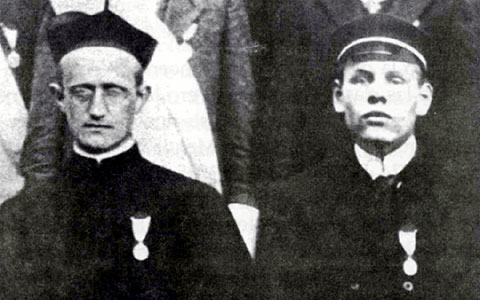 |
El Padre José Kentenich con José Engling Fr. Kentenich with Joseph Engling Pater Kentenich und Josef Engling Foto: Archiv © 2008 |
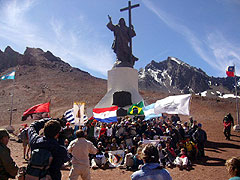 |
|
Jovenes que hoy se comprometen como José Engling Young people who today live their commitment like Joseph Engling Auch heute setzten junge Leute sich ein wie Josef Engling |
|
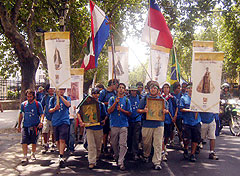 |
|
Con su radicalismo y entrega With radical love Mit der Radikalität der Jugend |
|
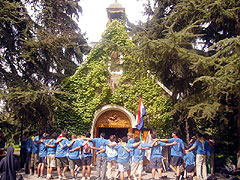 |
|
Viviendo del y para el Santuario Living from and for the Shrine Vom Heiligtum und für das Heiligtum Fotos: Cruzada de Andes 2007 © 2008 |
|
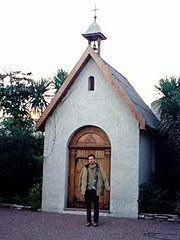 |
|
El „pequeño Santuario” en Buenos Aires The “small
Shrine” in
Das “kleine Heiligtum” in Buenos Aires Foto: Knes © 2008 |
|
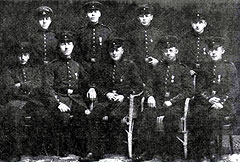 |
|
José Engling con congregantes – la semilla de Schoenstatt Joseph Engling with sodalists – seeds of Schoenstatt Josef Engling mit Sodalen – Schönstatts Anfang Foto: Archiv © 2008 |
|
|
SCHOENSTATT, mkf. According to Father Kentenich, he is the "Living Founding Document." Already one year after the death of Joseph Engling in 1919, Father Kentenich began publishing his letters and notes from his diary in the "MTA" Schoenstatt magazine. Amid the hell of Dachau, he wrote a prayer for the beatification of St. Vincent Pallotti (canonized in 1963) and Joseph Engling: "May Joseph Engling soon be canonized, too, so that all resistance may be overcome which obstructs our fruitfulness and prevents others from seeing the Father’s plan in faith." On June 17th, in the city of Tréveris, with an official act in the Gothic Room of the cathedral, the diocesan phase of the beatification process for Joseph Engling came to a close. This takes place on the 40th anniversary of the death of Father Kentenich and 40 years after he wrote with his own hand for the 50th anniversary of the death of Joseph Engling: "In the life of this young hero, you find someone who lived the founding document and anticipated, by means of a perfect example, the history of our foundation with its three contact points:" the Blessed Mother, the Father, and the Shrine.
Joseph Engling, a member of the founding generation of Schoenstatt, was born in a remote town of Eastern Prussia (then Germany, now Poland). He was a student at the Pallottine School in Schoenstatt. He was not present on October 18, 1914 at the birth of Schoenstatt when the Covenant of Love with the Blessed Mother was sealed by Father Kentenich and a group of students in the chapel which is today known as the "Original Shrine." He opened his heart without reserves and made Schoenstatt his life. The notes from his diary and his letters are a pure and profound reflection of the promptings passed on to him by Father Kentenich. Joseph offered his physical limitations…..his successes and his many apostolic failures…..his self-education and his setbacks as a soldier on the battlefields of the First World War for the growth and the expansion of Schoenstatt. On May 31, 1918, he offered his life for this intention. He died on October 4, 1918, near Cambrai, France. From these two places – Cambrai with its Shrine and Merville with its Wayside Shrine – innumerable vocations for Schoenstatt have blossomed from the youth and recently, a Schoenstatt springtime has begun in France. Resistance is overcome…..
Which is Joseph Engling’s charism? To awaken vocations for Schoenstatt…..to overcome resistance…..to show more clearly the plan of the Father in personal life and in the Work of Schoenstatt…..to awaken the desire to be "a second Joseph Engling" for a country, for a community…..for Schoenstatt…..for the Father…..today.
How did he prove that it is possible to love the Blessed Mother to the point of offering one’s life
"I met Schoenstatt in Buenos Aires in 1957 when I was completing the last year of study for my bachelor’s degree," relates a Schoenstatt Sister of Mary. "Two classmates who had arrived at the school that year belonged to Schoenstatt. Without their inviting me, one day I went with them to a weekday Holy Mass at the little Shrine in the German parish of St. Boniface which was mid-way from the school. It was the month of May. I immediately noticed that there was something exceptional there and I started going daily to that Mass.
Shortly thereafter, they invited me to participate in their group of girls’ youth. At that time, it was the only group in existence in Buenos Aires. There was also only one group of Boys’ Youth, and the future Fr. Esteban Uriburu was in the group.
At that time, the only thing we had to read was EVERYDAY SANCTITY which, of course, we would not read…..some copies of pages on the Hoerde Conference, which we also would not read…..HEAVENWARDS which was translated into Spanish verse form…..and best of all, the biography of JOSEPH ENGLING by Fr. Alex Menningen.
That book was something extraordinary for all of us. Joseph was our hero…..the model of a Catholic and a Schoenstatt youth…..the one who proved that it is possible to love the Blessed Mother to the point of offering one’s life, and not on a whim of enthusiasm but after "proving with deeds" (his May blossoms) that he really loved Her.
Joseph decidedly marked that era or my entrance into Schoenstatt and all the years that followed….. It was and is a continuous appeal for the highest. If he could…..what do I do? He was an example of how he was transformed by his relationship to the Father and Founder…..knowing he was worthy of his confidence…..the object of interest and of his paternal love, a sobering love, a masculine love.
Many years later, I also learned that Joseph was important in the life of Father Kentenich. He was his first spiritual son, he was the one who offered the "creative resultant" to his paternal activity. Joseph became a saint and Father Kentenich confirmed his paternal mission for all times!
I am very happy to know – thanks to Schoenstatt.de – that also today, many youths have him as their model. Perhaps soon, the Church can present him with his beatification as an example of what Schoenstatt (the Shrine, Blessed Mother and Father) can offer to everyone who follows this way."
If this Schoenstatt would still exist, I would join it immediately
"It was 1939 – I was 15 years old – we were in the full boom of national-socialism when the young chaplain from our parish, one day in the library gave me a book one day," relates Hubert Fischer with youthful enthusiasm to a group of youth.
"HERO IN DAILY LIFE," it was called. I took it as a novel, and page after page, it was a "novel" which increased my fascination. Alexander Menningen – an author who had read a great deal and who was completely unknown to me – described in this book the life of a young man, Joseph Engling, who impressed me greatly…..his surrender, his heroism, his harmonious attachment to daily life, and above all: this new style of professing the faith with total freedom, total generosity, total commitment. It was so new, so beautiful, that it could only be a novel. I thought, if this reality were ever Schoenstatt, what a loss its disappearance would be for the Church! If this Schoenstatt would exist, I would join it immediately. One day, the chaplain invited some boys to listen to a talk from an "interesting priest." This priest, after a sort of boring introduction, suddenly began talking about my novel! It was only a second: it is not a novel nor something which has disappeared. It exists and I can join them! Since that evening in the lounge of our parish, Schoenstatt is my life. It was during the battles of the Second World War; it was in the Russian trenches where I was injured and left handicapped (I lost a leg) and I was only 18 years old; it was during the time I worked for the Boys’ Youth and the Family Work; it was during moments of disillusionment with Schoenstatt’s humanness. Today, almost 70 years later, when I think about my journey with Schoenstatt, I can say: I wanted to be, in a very humble way, beside Father Kentenich another Joseph Engling who announces to the world that this Work of Father Kentenich is for the globalized world what St. Benedict was during the great migrations. May we never lessen or cheapen Father’s mission and it is worth it to offer one’s life for it,"…..like Joseph Engling.
Father Kentenich never wanted to act alone in Schoenstatt’s history. He always had at his side a Joseph Engling. He needs him and he also has him today so that all resistance may be overcome which obstructs our fruitfulness.
(reference made to HEAVENWARDS, American Edition p.137)
Translation: Carlos Cantú Family Federation La Feria, Texas USA 061608